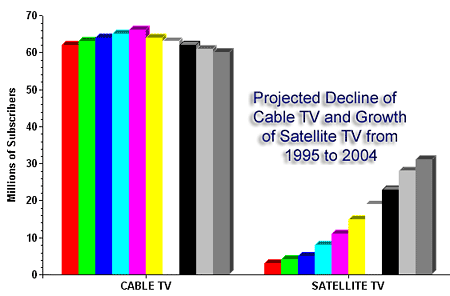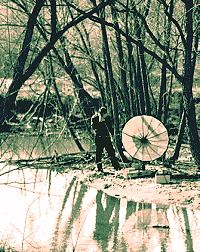Film, Radio and TV - 29 |
The medium that is now slowly taking over from coaxial cable
The medium of transmission is light. Light waves have an extremely high frequency and travel at 300,000-km (186,000-miles) per second. A single OF cable can theoretically carry trillions of bits of information every second. The thickness of an optical fiber is only slightly larger than a human hair. The photo on the right shows a light conducting OF strand going through the eye of a needle. Fiber optic cables normally carry numerous OF strands within a single enclosure. Compared to coaxial cable, optical fiber has ten advantages:
As cable and telephone companies continue to move toward optical fiber, eventually even home-to-home video transmissions will become as simple as dialing the right number. Satellites hovering about 36,000-kilometers (22,500-miles) above the earth relay most television programming to world viewers. Each satellite or "bird" is composed of a number of transponders, or independent receive-transmit units. Geosynchronous satellites rotate at the same speed as the earth and end up being stationary in relation to the earth's surface. This obviously simplifies the job of keeping them within the range of both the uplink and downlink
The reflector dish of a ground station uplink is shaped like a parabola, which is similar to the reflector of a powerful searchlight—the kind that can send a beam of light into the night sky. Signals reflected from the center element will hit the dish and then be sent upward on their 36,000-kilometer (22,500-mile) path to the satellite.
As illustrated on the right, once the signal is received, it is amplified, the frequency is changed, and then it is sent back to the earth. The "footprint" (coverage area) of the returning signal covers many thousands of square meters or miles of the earth's surface.
The signal from the satellite is collected in a dish and directed toward a receiving element, as shown on the right. This signal is then amplified thousands of times and fed to your TV receiver. Networks and TV production facilities routinely distribute their programming via satellite. This is typically how TV productions originating in the Los Angeles-Hollywood area
Once they arrive on the East Coast they are recorded, scheduled into the network agenda, commercials are typically added, and then the programs are beamed back up to satellites at intervals appropriate to the time zones across North America. W hen the network-to-affiliate link is not being used to relay regular programming, it's used to send news stories, program promotion segments, and other broadcast-related segments to affiliated stations. Stations not affiliated with a network can receive news and information from satellite services such as CNN. Cable (CATV) companies also receive much of their programming from satellites. This includes both TV and audio services. Many TV and audio services (satellite "stations") are not broadcast over the airwaves, but are only available directly from satellites. Satellite-to-Home Services For people living in rural areas out of the range of local TV and CATV services, a satellite receiver may be the only way they can view TV. Home satellite receivers can be cheaper in the long run than CATV services, and they open the door to hundreds of TV and audio channels. There are two basic divisions of satellite services: those that use the C-band and Ku-bands, and subscription services such as the Dish Network and Direct-TV. The latter services have seen a steady growth rate over the last few years. At the same time the number of cable-TV subscribers is declining. If the present rate of decline and growth continues through the year 2004, the following pattern will emerge.
Satellite-to-home services, such as Direct-TV, have their own satellites and home receiver systems. Unlike the C-band and Ku-band services, once you acquire this type of receiver and receiving dish, you are locked into the particular service—and the subscription fees that go along with it. Although many C- and Ku-band satellite services are scrambled (subscription based), there are several hundred free TV services ("stations") available. These include:
Even with the dozens of channels of free programming, the C-band and Ku band services have been declining in popularity. This is primarily because of the large dishes involved and the difficulties in finding the programming you are interested in on the dozens of satellites involved. Although much of the programming on C- and KU-bands is free, there are many scrambled satellite services, which means it's encrypted and only available by paid subscription. Pay-per-view movie channels, adult channels, and many on-air regional TV stations (often called superstations) work in this way. Once fees are paid, the unique identifying number in your satellite receiver is uplinked along with the TV satellite signal. This unlocks (unscrambles) the signal so it can be displayed on your TV set. C-band satellites, which typically carry 24 TV channels, have names such as Galaxy 9, Satcom C3 and Morelos 2. For example, the Florida Sunshine Network is on Satcom C1, Channel 24. Although most satellite TV programming is in English, Spanish or French, C- and Ku-band satellite programming is also available in dozens of other languages. A single C-band or Ku-band satellite channel is capable of carrying both a TV signal and one or more separate audio channels. Taking advantage of this fact are more than 100 free audio services, most in stereo and many without commercials. Some are standard radio stations that distribute their signal by satellite (such as CBM-AM in Quebec and WQXR-FM in New York). Others, which cover everything from classical to hard rock music, are music services only available by satellite. In recent years many C-band and Ku-band satellite services have moved from analog to digital signals. This has made it necessary for many home viewers to upgrade their satellite receivers. In the late '80s portable, freestanding satellite uplinks referred to as flyaway units were introduced for electronic newsgathering (ENG) work. These units can be disassembled and transported in packing cases to the scene of a news story. Within a few minutes the dishes can be aimed at the appropriate satellite, and "live" or recorded TV footage can be uplinked and then relayed to any part of the world. Flyaway units are used in remote regions, including offshore areas and third-world countries. A flyaway satellite uplink, complete with a telephone link, is shown in operation above.
|
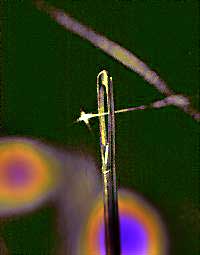 is fiber optics (also called optical fiber or OF) .
is fiber optics (also called optical fiber or OF) . 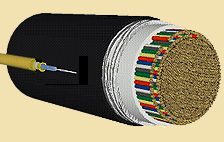 The
information carrying capacity of OF is hundreds of times greater
than a normal copper wire.(Note
on left the comparison between an optical fiber link and a
telephone cable with hundreds of wires.)
The
information carrying capacity of OF is hundreds of times greater
than a normal copper wire.(Note
on left the comparison between an optical fiber link and a
telephone cable with hundreds of wires.)
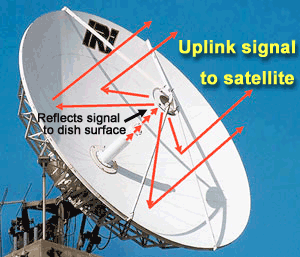 dishes on the earth.
dishes on the earth.  The signal from the uplink ground station is aimed along a precise path to the appropriate satellite.
The signal from the uplink ground station is aimed along a precise path to the appropriate satellite. 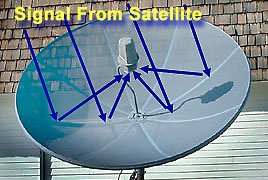 Within the footprint area receiving dishes work in reverse of the uplink ground stations.
Within the footprint area receiving dishes work in reverse of the uplink ground stations. 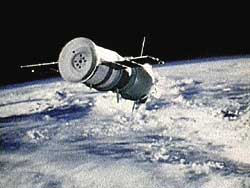 are sent to the East Coast for network distribution.
are sent to the East Coast for network distribution. 